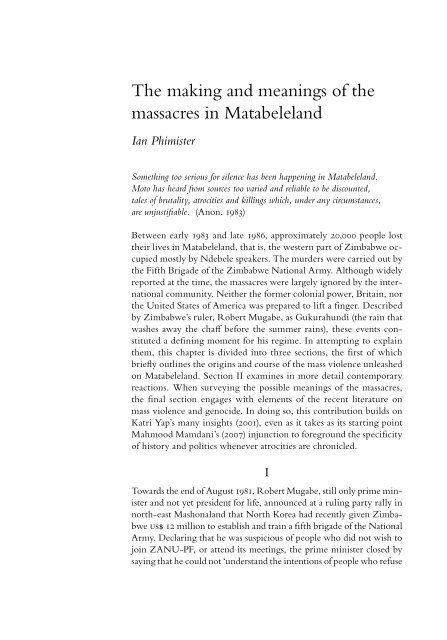60 years after the UN Convention - Dag Hammarskjöld Foundation
60 years after the UN Convention - Dag Hammarskjöld Foundation
60 years after the UN Convention - Dag Hammarskjöld Foundation
You also want an ePaper? Increase the reach of your titles
YUMPU automatically turns print PDFs into web optimized ePapers that Google loves.
The making and meanings of <strong>the</strong><br />
massacres in Matabeleland<br />
Ian Phimister<br />
Something too serious for silence has been happening in Matabeleland.<br />
Moto has heard from sources too varied and reliable to be discounted,<br />
tales of brutality, atrocities and killings which, under any circumstances,<br />
are unjustifi able. (Anon. 1983)<br />
Between early 1983 and late 1986, approximately 20,000 people lost<br />
<strong>the</strong>ir lives in Matabeleland, that is, <strong>the</strong> western part of Zimbabwe occupied<br />
mostly by Ndebele speakers. The murders were carried out by<br />
<strong>the</strong> Fifth Brigade of <strong>the</strong> Zimbabwe National Army. Although widely<br />
reported at <strong>the</strong> time, <strong>the</strong> massacres were largely ignored by <strong>the</strong> international<br />
community. Nei<strong>the</strong>r <strong>the</strong> former colonial power, Britain, nor<br />
<strong>the</strong> United States of America was prepared to lift a fi nger. Described<br />
by Zimbabwe’s ruler, Robert Mugabe, as Gukurahundi (<strong>the</strong> rain that<br />
washes away <strong>the</strong> chaff before <strong>the</strong> summer rains), <strong>the</strong>se events constituted<br />
a defi ning moment for his regime. In attempting to explain<br />
<strong>the</strong>m, this chapter is divided into three sections, <strong>the</strong> fi rst of which<br />
briefl y outlines <strong>the</strong> origins and course of <strong>the</strong> mass violence unleashed<br />
on Matabeleland. Section II examines in more detail contemporary<br />
reactions. When surveying <strong>the</strong> possible meanings of <strong>the</strong> massacres,<br />
<strong>the</strong> fi nal section engages with elements of <strong>the</strong> recent literature on<br />
mass violence and genocide. In doing so, this contribution builds on<br />
Katri Yap’s many insights (2001), even as it takes as its starting point<br />
Mahmood Mamdani’s (2007) injunction to foreground <strong>the</strong> specifi city<br />
of history and politics whenever atrocities are chronicled.<br />
I<br />
Towards <strong>the</strong> end of August 1981, Robert Mugabe, still only prime minister<br />
and not yet president for life, announced at a ruling party rally in<br />
north-east Mashonaland that North Korea had recently given Zimbabwe<br />
us$ 12 million to establish and train a fi fth brigade of <strong>the</strong> National<br />
Army. Declaring that he was suspicious of people who did not wish to<br />
join ZANU-PF, or attend its meetings, <strong>the</strong> prime minister closed by<br />
saying that he could not ‘understand <strong>the</strong> intentions of people who refuse

















